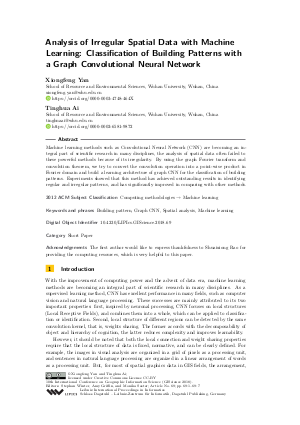Analysis of Irregular Spatial Data with Machine Learning: Classification of Building Patterns with a Graph Convolutional Neural Network (Short Paper)
Authors
Xiongfeng Yan  ,
Tinghua Ai
,
Tinghua Ai 
-
Part of:
Volume:
10th International Conference on Geographic Information Science (GIScience 2018)
Part of: Series: Leibniz International Proceedings in Informatics (LIPIcs)
Part of: Conference: International Conference on Geographic Information Science (GIScience) - License:
 Creative Commons Attribution 3.0 Unported license
Creative Commons Attribution 3.0 Unported license
- Publication Date: 2018-08-02
File

PDF
LIPIcs.GISCIENCE.2018.69.pdf
- Filesize: 0.65 MB
- 7 pages
Document Identifiers
Subject Classification
ACM Subject Classification
- Computing methodologies → Machine learning
Keywords
- Building pattern
- Graph CNN
- Spatial analysis
- Machine learning
Metrics
- Access Statistics
-
Total Accesses (updated on a weekly basis)
0PDF Downloads0Metadata Views
Abstract
Machine learning methods such as Convolutional Neural Network (CNN) are becoming an integral part of scientific research in many disciplines, the analysis of spatial data often failed to these powerful methods because of its irregularity. By using the graph Fourier transform and convolution theorem, we try to convert the convolution operation into a point-wise product in Fourier domain and build a learning architecture of graph CNN for the classification of building patterns. Experiments showed that this method has achieved outstanding results in identifying regular and irregular patterns, and has significantly improved in comparing with other methods.
Cite As Get BibTex
Xiongfeng Yan and Tinghua Ai. Analysis of Irregular Spatial Data with Machine Learning: Classification of Building Patterns with a Graph Convolutional Neural Network (Short Paper). In 10th International Conference on Geographic Information Science (GIScience 2018). Leibniz International Proceedings in Informatics (LIPIcs), Volume 114, pp. 69:1-69:7, Schloss Dagstuhl – Leibniz-Zentrum für Informatik (2018)
https://doi.org/10.4230/LIPIcs.GISCIENCE.2018.69
BibTex
@InProceedings{yan_et_al:LIPIcs.GISCIENCE.2018.69,
author = {Yan, Xiongfeng and Ai, Tinghua},
title = {{Analysis of Irregular Spatial Data with Machine Learning: Classification of Building Patterns with a Graph Convolutional Neural Network}},
booktitle = {10th International Conference on Geographic Information Science (GIScience 2018)},
pages = {69:1--69:7},
series = {Leibniz International Proceedings in Informatics (LIPIcs)},
ISBN = {978-3-95977-083-5},
ISSN = {1868-8969},
year = {2018},
volume = {114},
editor = {Winter, Stephan and Griffin, Amy and Sester, Monika},
publisher = {Schloss Dagstuhl -- Leibniz-Zentrum f{\"u}r Informatik},
address = {Dagstuhl, Germany},
URL = {https://drops.dagstuhl.de/entities/document/10.4230/LIPIcs.GISCIENCE.2018.69},
URN = {urn:nbn:de:0030-drops-93973},
doi = {10.4230/LIPIcs.GISCIENCE.2018.69},
annote = {Keywords: Building pattern, Graph CNN, Spatial analysis, Machine learning}
}
Author Details
References
- Joan Bruna, Wojciech Zaremba, Arthur Szlam, and Yann LeCun. Spectral networks and locally connected networks on graphs. CoRR, 2013. URL: http://arxiv.org/abs/1312.6203.
- Michaël Defferrard, Xavier Bresson, and Pierre Vandergheynst. Convolutional neural networks on graphs with fast localized spectral filtering. CoRR, 2016. URL: http://arxiv.org/abs/1606.09375.
- Shihong Du, Liqun Luo, Kai Cao, and Mi Shu. Extracting building patterns with multilevel graph partition and building grouping. ISPRS Journal of Photogrammetry and Remote Sensing, 122:81-96, 2016. URL: http://dx.doi.org/10.1016/j.isprsjprs.2016.10.001.
- Shihong Du, Mi Shu, and Chen Chieh Feng. Representation and discovery of building patterns: a three-level relational approach. International Journal of Geographical Information Science, 30(6):1161-1186, 2015. URL: http://dx.doi.org/10.1080/13658816.2015.1108421.
- David K. Hammond, Pierre Vandergheynst, and Rémi Gribonval. Wavelets on graphs via spectral graph theory. Applied and Computational Harmonic Analysis, 30(2):129-150, 2009. URL: http://dx.doi.org/10.1016/j.acha.2010.04.005.
- Xianjin He, Xinchang Zhang, and Qinchuan Xin. Recognition of building group patterns in topographic maps based on graph partitioning and random forest. ISPRS Journal of Photogrammetry and Remote Sensing, 136:26-40, 2018. URL: http://dx.doi.org/10.1016/j.isprsjprs.2017.12.001.
- David I Shuman, Benjamin Ricaud, and Pierre Vandergheynst. Vertexfrequency analysis on graphs. Applied and Computational Harmonic Analysis, 40(2):260-291, 2016. URL: http://dx.doi.org/10.1016/j.acha.2015.02.005.
- Zhiwei Wei, Qingsheng Guo, Lin Wang, and Fen Yan. On the spatial distribution of buildings for map generalization. Cartography and Geographic Information Science, pages 1-17, 2018. URL: http://dx.doi.org/10.1080/15230406.2018.1433068.
- Liqiang Zhang, Hao Deng, Dong Chen, and Zhen Wang. A spatial cognition-based urban building clustering approach and its applications. International Journal of Geographical Information Science, 27(4):721-740, 2013. URL: http://dx.doi.org/10.1080/13658816.2012.700518.
- Xiang Zhang, Tinghua Ai, Stoter Jantien, Kraak Menno Jan, and Molenaar Martien. Building pattern recognition in topographic data: examples on collinear and curvilinear alignments. GeoInformatica, 17(1):1-33, 2013. URL: http://dx.doi.org/10.1007/s10707-011-0146-3.
